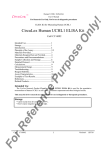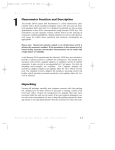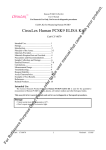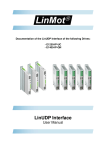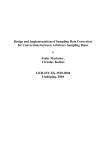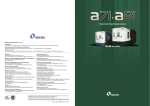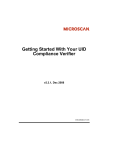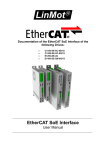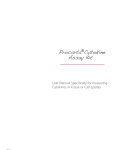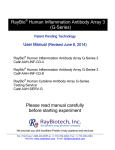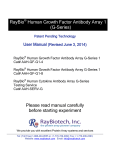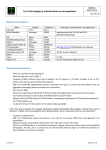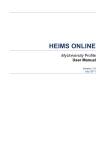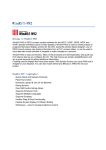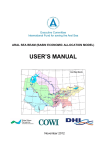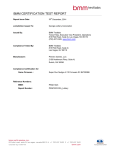Download CY-1250 Cathepsin S Fluorometric Assay Kit
Transcript
ly ! Cathepsin S Fluorometric Assay Kit User’s Manual For Research Use Only, Not for use in diagnostic procedures On Fluorometric Assay Kit for measuring Cathepsin S Activity CycLex Cathepsin S Fluorometric Assay Kit For 100 Assays rp Pu Intended Use................................................ 1 Storage......................................................... 1 Introduction.................................................. 2 Principle of the Assay.................................. 2 Materials Provided....................................... 3 Materials Required but not Provided........... 3 Precautions and Recommendations............. 3 Detailed Protocol......................................... 4-7 Evaluation of Results....................................8-10 Sample Preparation......................................11 Troubleshooting.......................................... 12 Reagent Stability......................................... 12 References................................................... 12 Related Products.......................................... 13 os e Cat# CY-1250 en ce Intended Use The CycLex Research Product CycLex Cathepsin S Fluorometric Assay Kit detects cathepsin S protease activity in cell lysates. Primarily, the CycLex Research Product CycLex Cathepsin S Fluorometric Assay Kit is designed for the rapid and sensitive evaluation of cathepsin S inhibitors using recombinant cathepsin S. Additionally, many cultured primary cells or cell lines can be assayed for cathepsin S protease activity with the CycLex Research Product CycLex Cathepsin S Fluorometric Assay Kit, if the appropriate treatment of cathepsin S is conducted. er Applications for this kit include: 1) Monitoring cathepsin S activity at purification step. 2) Screening inhibitors or activators of cathepsin S. 3) Evaluating the effects of pharmacological agents on cathepsin S activity. This assay kit is for research use only and not for use in diagnostic or therapeutic procedures. ef Storage rR • Upon receipt store Recombinant Cathepsin S at -70°C and all other components below -20°C. • Don’t expose reagents to excessive light. Fo Cat#: CY-1250 1 Version#: 120420 On Introduction ly ! Cathepsin S Fluorometric Assay Kit User’s Manual For Research Use Only, Not for use in diagnostic procedures os e Cathepsin S is a cysteine protease found in the lysosome of lymphatic cells. It is a member of the papain superfamily and has 57% identity to cathepsins L and K. Unlike most other lysosomal proteases that are only active under acidic conditions, the activity of cathepsin S exhibits a broad pH optimum that extends to alkaline pH. Cathepsin S is expressed mainly in dendritic cells, B cells, and macrophages, where cathepsin S acts as a key enzyme in major histocompatibility complex class II mediated antigen presentation (1, 2). Cathepsin S is upregulated by IFNγ through the IFN stimulated response element in the cathepsin S promoter. This enzyme is also implicated in the pathogenesis of several diseases such as rheumatoid arthritis, multiple sclerosis (3, 4), atherosclerosis (5-7), cancer (8, 9), Alzheimer’s and Down’s Syndrome (10). It is an attractive target for drug discovery due to its involvement in immune system function as well as extracellular matrix breakdown. rp Principle of the Assay Summary of Procedure Pu The CycLex Cathepsin S Fluorometric Assay Kit is based on an exclusive fluorescence substrate, Z-Val-Val-Arg-MCA (Benzyloxycarbonyl-L-Valyl-L-Valyl-L-Arginine 4-Methyl- Coumaryl-7-Amide). This homogenous assay kit is sensitive and convenient. This method of measurement should raise the efficiency of inhibitor screening and biochemical analysis of this enzyme. Mix 40 µL of Assay mixture containing Recombinant Cathepsin S and 5 µL of test en ce compound in the wells. Add 5 µL of 10X Fluoro-Substrate. Measure velocity of fluorescence intensity with excitation at 355-380 nm and emission at rR ef er 440-460 nm.for 20-30 min at 30°C. Fo Cat#: CY-1250 2 Version#: 120420 On Materials Provided ly ! Cathepsin S Fluorometric Assay Kit User’s Manual For Research Use Only, Not for use in diagnostic procedures All samples and Recombinant Cathepsin S should be assayed in duplicate. The following components are supplied and are sufficient for one hundred assays. Components of Kit Storage -20°C -20°C -70°C -20°C -20°C Room temp. 8X Assay Buffer 10X Fluoro-Substrate ( 100 µM Z-Val-Val-Arg-MCA) 5X Recombinant Cathepsin S, Human (c.a. 25 ng/µL) 100X Cysteine protease Inhibitor (0.1 mM E-64 in DMSO) 100X AMC standard (100 µM 7-amino-4-methylcoumarin) Instruction Manual Materials Required but not Provided rp ① ② ③ ④ ⑤ ⑥ Quantity 800 µL x 1 550 µL x 1 110 µL x 1 20 µL x 1 50 µL x 1 1 os e Components en ce Pu • Microtiter plate suitable for use with a fluorometric plate reader (black microplates provide better signal to noise ratio) • Microplate reading fluorometer: capable of excitation at a wavelength in the range 355-380 nm and detection of emitted light in the range 440-460 nm • Pipettors: 2-20 µL, 20-200 µL and 200-1000 µL precision pipettors with disposable tips • Multi-channel pipette • Microtiter plate shaker • Distilled water (DW) or equivalent high quality water • Microcentrifuge and tubes for sample preparation • Reagent reservoirs • Ice bucket to keep reagents cold until use • DMSO: Dimethyl Sulfoxide (Sigma: Cat# D2438) Precautions and Recommendations rR ef er • Please avoid repeated freezing and thawing of the Recombinant Cathepsin S in this kit. There is a possibility that the enzyme activity may be inactivated. Aliquot to 10-20 µL and store at –70°C. • Do not use kit components beyond the indicated kit expiration date. • Rinse all detergent residue from glassware. • Use deionized water of the highest quality (ddH2O). • Do not mix reagents from different kits. • Do not mouth pipette or ingest any of the reagents. • Do not smoke, eat, or drink when performing the assay or in areas where samples or reagents are handled. • Biological samples may be contaminated with infectious agents. Do not ingest, expose to open wounds or breathe aerosols. Wear protective gloves and dispose of biological samples properly. Fo Cat#: CY-1250 3 Version#: 120420 On Detailed Protocol ly ! Cathepsin S Fluorometric Assay Kit User’s Manual For Research Use Only, Not for use in diagnostic procedures The CycLex Research Product CycLex Cathepsin S Fluorometric Assay Kit is provided with concentrated reagents. Disposable pipette tips and reagent troughs should be used for all liquid transfers to avoid cross-contamination of reagents or samples. os e Preparation of Reagents within the kit Thaw the reagents at room temperature except “Recombinant Cathepsin S” and keep all reagents on ice until use. Use them only after they are completely thawed and mixed. rp #1. Prepare Assay Buffer by adding 5 µL of the ①8X Assay Buffer (provided) to 35 µL of distilled (deionized) water per one assay. Mix well. Unused buffer should be stored at -20°C. Discard any unused Assay Buffer after use. Assay Buffer Distilled water ①8X Assay Buffer 8 assays 16 assays 32 assays 48 assays 35 µL 5 µL 280 µL 40 µL 560 µL 80 µL 1,120 µL 160 µL 1,680 µL 240 µL 40 µL 320 µL 640 µL 1,280 µL 1,920 µL en ce Total volume of Assay Buffer 1 assay Pu Assay reagents #2. Prepare 1X Recombinant Cathepsin S by diluting the ③5X Recombinant Cathepsin S (provided) 1: 5 in 1X Assay Buffer. Mix well. Put it in ice. Discard any unused 1X Recombinant Cathepsin S after use. Assay reagents 1X Assay Buffer ③5X Recombinant Cathepsin S er Total volume 1 assay 8 assays 16 assays 32 assays 48 assays 8 µL 2 µL 40 µL 10 µL 72 µL 18 µL 136 µL 34 µL 200 µL 50 µL 10 µL 50 µL 90 µL 170 µL 250 µL rR ef #3. Prepare 10X Cysteine protease Inhibitor (10 µM E-64) by adding 2 µL of the ④ 100X Cysteine protease Inhibitor (provided) to 18 µL of distilled (deionized) water. Mix well. Discard any unused 10X Cysteine protease Inhibitor after use. Fo Cat#: CY-1250 4 Version#: 120420 On Inhibitor Screening Assay Procedure ly ! Cathepsin S Fluorometric Assay Kit User’s Manual For Research Use Only, Not for use in diagnostic procedures os e In order to estimate the inhibitory effect on Cathepsin S activity by the test compounds correctly, it is necessary to conduct the control experiment of “Vehicle control” at least once for every experiment and “Inhibitor control” at least once for the first experiment, in addition to “Test sample” as indicated in the Table.1 (below). When test chemicals cause an inhibitory effect on Cathepsin S activity, the level of increase of fluorescence intensity is weakened as compared with “Vehicle control”. The increase in fluorescence intensity is not observed in “Inhibitor control”. 1) Following Table.1 below, first, add “Assay mixture” to microtiter plate wells. Second, add “Test Compound” or “Vehicle of Test Compound” or “10X Cathepsin S Inhibitor” and 1X Recombinant Cathepsin S to each well of the microtiter plate and mix well*. rp *Optional: For best accuracy, it is advisable to pre-incubate the plate for 5-10 min. at assay temperature. Table 1: Reaction mixture Test Sample Vehicle Control 35 µL 35 µL 35 µL 35 µL 5 µL - 5 µL - 5 µL 5 µL - Pu Assay reagents Assay Buffer* en ce Test Compound Vehicle of Test Compound 10X Cysteine protease Inhibitor (10 µM E-64)* Inhibitor No Enzyme Control Control 1X Recombinant Cathepsin S (5 ng/µL)* Assay Buffer 5 µL - 5 µL - 5 µL - 5 µL Total Volume 45 µL 45 µL 45 µL 45 µL * See page 4, section “Preparation of Reagents within the kit” er 2) Initiate reactions by adding 5 µL of ② 10X Fluoro-Substrate to each well and mixing thoroughly. 3) Read fluorescence intensity for 20-30 min or desired length of time at 2 to 5 minute intervals using microtiter plate fluorometer with excitation at 355-380 nm and emission at 440-460 nm at 30°C*. ef * Any assay temperature from room temperature to 37°C may be used. 4) Measure and calculate the rate of reaction while the reaction velocity remains constant. rR Caution and Significance • All samples and “Recombinant Cathepsin S” should be assayed in duplicate. • Use of a microtiter plate shaker is recommended for complete mixing. • If the test compounds or samples themselves emit fluorescence at excitation wavelength: 355-380 nm and fluorescence wavelength: 440-460 nm, the test assay cannot be evaluated correctly. Fo Cat#: CY-1250 5 Version#: 120420 On Cathepsin S Activity Assay Procedure ly ! Cathepsin S Fluorometric Assay Kit User’s Manual For Research Use Only, Not for use in diagnostic procedures os e In order to correctly measure the activity of Cathepsin S in cell lysate, it is necessary to conduct the control experiment of “Inhibitor control” at least once for every experiment and “Positive control” at least once for the first experiment, in addition to “No enzyme control” as indicated in the following table. Here “Cathepsin S activity” is defined as neutral pH treatment resistant cysteine protease activity in cell lysate using this kit. Thus the neutral pH treatment of cell lysate is required for measuring “Cathepsin S activity” in cell lysate (See page 11, section “ Sample Preparation”). Although the level of fluorescent intensity increases in “Test sample” when Cathepsin S enzyme activity is in the sample, the significant reduced reaction velocity is observed in “Inhibitor control” and “No enzyme control”. rp 1) Following Table.1 below, first, add “Assay Buffer” to microtiter plate wells. Second, add “10X Cysteine protease Inhibitor” or “Vehicle of Cysteine protease Inhibitor” and “1X Recombinant Cathepsin S or “Your enzyme fraction (Neutral pH treated)” or “Buffer for cell lysate” to each well of the microtiter plate and mix well*. Table 2: Reaction mixture Assay reagents Assay Buffer* 10X Cysteine protease Inhibitor (10 µM)* Pu *Optional: For best accuracy, it is advisable to pre-incubate the plate for 5-10 min. at assay temperature. Positive control 35 µL No enzyme control 35 µL - 5 µL - - 5 µL - 5 µL 5 µL - - 5 µL - 5 µL 5 µL - - - - - 5 µL 45 µL 45 µL 45 µL 45 µL en ce Vehicle of 10X Cysteine protease Inhibitor* 35 µL Inhibitor control 35 µL Test Sample 1X Recombinant Cathepsin S (5 ng/µL) * Your enzyme fraction (Neutral pH treated) ** Buffer for cell lysate** Total Volume er * See page 4, section “Preparation of Reagents within the kit” ** See page 11, section “ Sample Preparation” ef 2) Following the above table, add the Reagents to each well of the microplate. Finally, initiate the reaction by adding 5 µL of ② 10X Fluoro-Substrate to each well and mixing thoroughly. 3) Read fluorescence intensity for 20-30 min or desired length of time at 2 to 5 minute intervals using microtiter plate fluorometer with excitation at 355-380 nm and emission at 440-460 nm at 30°C*. rR * Any assay temperature from room temperature to 37°C may be used. 4) Measure and calculate the rate of reaction while the reaction velocity remains constant. Fo Cat#: CY-1250 6 Version#: 120420 On Determine microplate reader conversion factor for AMC fluorophore ly ! Cathepsin S Fluorometric Assay Kit User’s Manual For Research Use Only, Not for use in diagnostic procedures Typiacl AMC Standard Curve AMC Standard Curve rp Pu 50,000 25,000 y = 69296x - 89.725 en ce RFU (F355/F460) 75,000 os e The exact AMC concentration range that will be useful for preparing a standard curve will vary depending on the fluorometer model, the gain setting, and the exact excitation and emission wavelengths used. Please dilute the 100X AMC standard (provided; 100 μM) to 1.0 μM as the highest standard and make 4-fold serial dilution with Assay Buffer and then measuring the fluorescence of 50 μl in a microtiter plate fluorometer with excitation at 355-380 nm and emission at 440-460 nm. The estimate of μM/RFU obtained with this measurement, together with the observed range of values obtained in the enzyme assays, can then be used to plan an appropriate series of dilutions for a standard curve. The slope of the standard curve can then be used as the μM/RFU conversion factor. 2 R =1 0 0.3 0.5 AMC conc. ( uM ) 0.8 1.0 rR ef er 0.0 Fo Cat#: CY-1250 7 Version#: 120420 On Evaluation of Results ly ! Cathepsin S Fluorometric Assay Kit User’s Manual For Research Use Only, Not for use in diagnostic procedures Analysis of Kinetics Time course curve os e 1. Run reactions as described in the Detailed Protocol. 2. Subtract fluorescence intensity at the 0 time from all reaction time points. 3. Plot fluorescence intensity at 460 nm versus reaction time. 4. Determine the reaction time range in which the increase in fluorescence intensity at 460 nm is linear. 5. Calculate activity: Fluorescence Intensity of Test Sample Activity (reaction velocity) = rp Reaction time (min.) Fig.1 Typical Time Course Curve Pu NOTE: Usually, the linear range is from 0 to 15 min. This value is variable depending on reaction conditions and storage/handling of the Recombinant Cathepsin S. Decreasing the amount of Recombinant Cathepsin S in the assay may help to lengthen the time range. Cathepsin S Time Course en ce 100 75 25 ng 50 er RFU (F355/F460) x 10-3 125 blank ef 25 0 rR 0 Fo Cat#: CY-1250 10 20 30 40 Time (min.) 8 50 60 70 Version#: 120420 On Analysis of Inhibitor Effect #1 ly ! Cathepsin S Fluorometric Assay Kit User’s Manual For Research Use Only, Not for use in diagnostic procedures % Intensity os e 1. Run reactions with test compounds and Vehicle as described in the Detailed Protocol. 2. Subtract fluorescence intensity of “No Enzyme Control” from all experimental samples (Test Samples and Vehicle Control). 3. Calculate the % Intensity: Reaction velocity of Test Sample % Intensity = X 100 Reaction velocity of Vehicle Control Pu Fig.2 Typical Inhibition Curve by E-64 rp NOTE: This % Intensity is a rough value of enzyme activity or inhibition. For greater accuracy, plot a standard curve of Cathepsin S for each new set of reactions and estimate the % Activity (see below). Inhibition of Cathepsin S by E-64 en ce 2,000 RFU/min 1,500 1,000 er 500 rR ef 0 1E-05 0.0001 0.001 Fo Cat#: CY-1250 0.01 0.1 E64 conc. (µM) 9 1 10 100 Version#: 120420 On Analysis of Inhibitor Effect #2 ly ! Cathepsin S Fluorometric Assay Kit User’s Manual For Research Use Only, Not for use in diagnostic procedures Cathepsin S Standard Curve and % Activity os e 1. Dilute the ①8X Assay Buffer 1:8 with distilled water to make 1X Assay Buffer. 2. Make serial dilutions of Recombinant Cathepsin S with 1X Assay Buffer (ex. 100 %, 50 %, 25 %, 12.5 % 6.25 % , 3.13 % and 0 %). 3. Run reactions with Vehicle and serial dilutions of Recombinant Cathepsin S as described in the Detailed Protocol. 4. Plot standard curve data as fluorescence intensity at 460 nm versus dose of Cathepsin S (ng/assay). 5. Obtain a line-fit to the data using appropriate calculations. 6. Use the slope and Y-intercept to calculate the amount of Cathepsin S activity for the experimental data. rp Fig.3 Typical Dose Dependency Curve Cathepsin S Dose Dependency 125 25 ng 3.125 ng 1.5625 ng 75 0 50 en ce RFU (F355/F460) x 10-3 6.25 ng Pu 12.5 ng 100 25 0 0 10 20 30 40 50 60 70 Time (min.) Cathepsin S Dose Dependency er 2,500 1,500 ef RFU/min 2,000 1,000 rR 500 Fo Cat#: CY-1250 0 0 5 10 15 Cathepsin S (ng) 10 20 25 Version#: 120420 On Sample Preparation ly ! Cathepsin S Fluorometric Assay Kit User’s Manual For Research Use Only, Not for use in diagnostic procedures os e The following protocols have been shown to work with a number of different cells and enzyme sources and are provided as examples of suitable methods. Crude samples can frequently be used without dilution while more concentrated or highly purified cathepsin S should be diluted. It is strongly advised that the user always perform an initial experiment to determine the proper dilution to be used in subsequent experiments. This need not be any more than a single time point assay using serial dilutions of the crude extract, cell lysate or sample fraction taken prior to a purification step. All sample preparation should be performed at 4°C and recovered fractions should be kept at -70°C to prevent loss of enzymatic activity. Preparation of Cell Lysate rp Note: This protocol has been successfully applied to several cell lines. Users should optimize the cell extraction procedure for their own applications. 2. Wash cells twice with cold PBS. Pu 1. Collect cells in PBS by centrifugation (~107 non-adherent cells) or scraping from 10 cm culture dish (adherent cells). 3. Remove and discard the supernatant completely and collect the cell pellet. At this point the cell pellet can be frozen at -80°C and lyse at a later date. en ce 4. Lyse the cell pellet in 0.2 mL of ice-cold Cell Lysis Buffer for 30 minutes, on ice, with vortexing at 10-minute intervals. Cell Lysis Buffer (1X): 10 mM HEPS (pH 7.5), 100 mM NaCl, 2 mM EDTA, 2 mM EGTA, 0.2 % Triton X-100, 2 mM DTT. 5. Microcentrifuge at top speed for 10 minutes at 4°C, and transfer the supernatant to a new tube. The supernatant is the cell lysate. If necessary, cell lysate can be stored at –80°C. 6. Before the assay, preincubated the cell lysate in Cell Lysis Buffer (pH7.5) at 37 °C for 60 min in order to inactivate cathepsins L and B, which would also hydrolyze same substrate. er 7. Go to section “Cathepsin S Activity Assay Procedure”, page 6. rR ef NOTE: THE ABOVE PROCEDURES ARE INTENDED ONLY AS A GUIDELINE. THE OPTIMAL EXPERIMENTAL CONDITIONS WILL VARY DEPENDING ON THE PARAMETERS BEING INVESTIGATED, AND MUST BE DETERMINED BY THE INDIVIDUAL USER. NO WARRANTY OR GUARANTEE OF PERFORMANCE USING THESE PROCEDURES IS MADE OR IMPLIED. Fo Cat#: CY-1250 11 Version#: 120420 On Fig.4 Effect of 37°C-pretreatment on cathepsin-like protease activities Cathepsin-like protease Activities os e 300 250 HepG2 No treatment HepG2 37℃ pretreatment Sw480 No treatment Sw480 37℃ pretreatment Lovo No treatment Lovo 37℃ pretreatment A431 No treatment A431 37℃ pretreatment -3 200 rp 150 100 Pu Counts (F355/F460) x 10 ly ! Cathepsin S Fluorometric Assay Kit User’s Manual For Research Use Only, Not for use in diagnostic procedures 50 10 20 30 40 Time (min.) 50 60 70 rR ef er 0 en ce 0 Fo Cat#: CY-1250 12 Version#: 120420 On Troubleshooting ly ! Cathepsin S Fluorometric Assay Kit User’s Manual For Research Use Only, Not for use in diagnostic procedures 1. The Recombinant Cathepsin S should be run in duplicate using the protocol described in the Detailed Protocol. Incubation times or temperatures significantly different from those specified may give erroneous results. os e 2. The reaction curve is nearly a straight line if the kinetics of the assay is of the first order. Variations in the protocol can lead to non-linearity of the curve, as can assay kinetics of other than first order. For a non-linear curve, point to point or quadratic curve fit methods should be used. 3. Poor duplicates, accompanied by elevated values for wells containing no sample, indicate inaccurate dispensing of assay reagents. If all instructions in the Detailed Protocol were followed accurately, such results indicate a need for multi-channel pipette maintenance. rp Reagent Stability Pu All of the reagents included in the CycLex Cathepsin S Fluorometric Assay Kit have been tested for stability. Reagents should not be used beyond the stated expiration date. Upon receipt, all kit reagents, except Recombinant Cathepsin S, should be stored at -20°C. Recombinant Cathepsin S should be stored at -70°C. After use, return kit reagents to -20°C as soon as possible. For research use only, not for use in human, diagnostic or therapeutic procedures. References rR ef er en ce 1. Honey, K and AY. Rudensky, Nat Rev Immunol. 3: 472, 2003 2. Hsieh, CS. et al. J Immunol. 168: 2618, 2002 3. S.N. Desai et al. Eur. J. Pharmacol. 538: 168, 2006 4. J.O. Link and S. Zipfel. Curr. Opin. Drug Discov. Devel. 9: 471, 2006 5. Kenneth J. et al. Arterioscler. Thromb. Vasc. Biol. 26: 851, 2006 6. Aikawa, E. et al. Circulation, April 7, 2009; 119(13): 1785 7. de Nooijer, R. et al. Arterioscler. Thromb. Vasc. Biol. 29: 188, 2009 8. Wang, B. et al. J. Biol. Chem. 281: 6020, 2006 9. Flannery, T. et al. Int. J. Cancer. 119: 854, 2006 10. Cynthia, A. et al. Am. J. Pathol. 146: 848, 1995 Fo Cat#: CY-1250 13 Version#: 120420 On Related Products ly ! Cathepsin S Fluorometric Assay Kit User’s Manual For Research Use Only, Not for use in diagnostic procedures en ce PRODUCED BY Pu rp os e * Cysteine Protease Cathepsin S: Cat# CY-E1250 CycLex Co., Ltd. 1063-103 Terasawaoka Ina, Nagano 396-0002 Japan Fax: +81-265-76-7618 e-mail: [email protected] URL: http://www.cyclex.co.jp rR ef er CycLex/CircuLex products are supplied for research use only. CycLex/CircuLex products and components thereof may not be resold, modified for resale, or used to manufacture commercial products without prior written approval from CycLex Co., Ltd.. To inquire about licensing for such commercial use, please contact us via email. Fo Cat#: CY-1250 14 Version#: 120420














